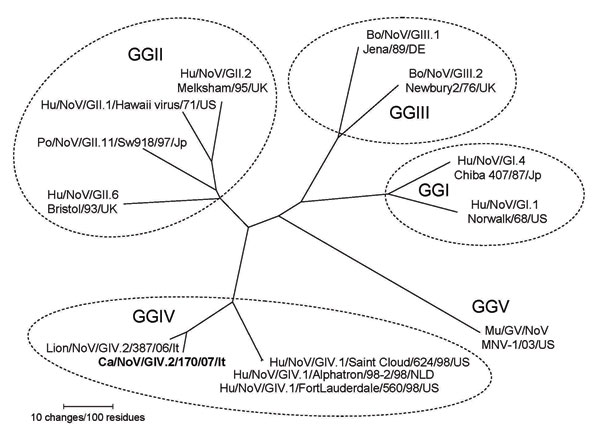Volume 14, Number 8—August 2008
Dispatch
Detection and Molecular Characterization of a Canine Norovirus
Figure 2

Figure 2. Phylogenetic tree constructed on the full-length amino acid sequence of the capsid protein. The tree was constructed by using a selection of norovirus (NoV) strains representative of the genogroups I to V. Phylogenetic analysis (neighbor-joining) with bootstrap analysis (1,000 replicates) and Kimura 2-parameter correction was conducted by using the MEGA software package version 3.0 (14). Strains designation follows the outlines of Wang et al. (10) and Zheng et al. (13). Bo, bovine; po, porcine; mu, murine; hu, human; ca canine.
References
- Green KY, Chanock RM, Kapikian AZ. Human caliciviruses. In: Knipe DM, Howley PM, editors. Fields virology, 4th ed., vol. 2. Philadelphia: Lippincott Williams & Wilkins; 2001. p. 841–74.
- Crandell RA. Isolation and characterization of caliciviruses from dogs with vesicular genital diseases.Arch Virol. 1988;98:65–71. DOIPubMedGoogle Scholar
- Martella V, Pratelli A, Gentile M, Buonavoglia D, Decaro N, Fiorente P, Analysis of the capsid protein gene of a feline-like calicivirus isolated from a dog.Vet Microbiol. 2002;85:315–22. DOIPubMedGoogle Scholar
- Schaffer FL, Soergel ME, Black JW, Skilling DE, Smith AW, Cubitt WD. Characterization of a new calicivirus isolated from feces of a dog.Arch Virol. 1985;84:181–95. DOIPubMedGoogle Scholar
- Mochizuki M, Kawanishi A, Sakamoto H, Tashiro S, Fujimoto R, Ohwaki M. A calicivirus isolated from a dog with fatal diarrhoea.Vet Rec. 1993;132:221–2.PubMedGoogle Scholar
- Matsuura Y, Tohya Y, Nakamura K, Shimojima M, Roerink F, Mochizuki M, Complete nucleotide sequence, genome organization and phylogenetic analysis of the canine calicivirus.Virus Genes. 2002;25:67–73. DOIPubMedGoogle Scholar
- Mochizuki M, Hashimoto M, Roerink F, Tohya T, Matsuura Y, Sasaki N. Molecular and seroepidemiological evidence of canine calicivirus infections in Japan.J Clin Microbiol. 2002;40:2629–31. DOIPubMedGoogle Scholar
- Jang HK, Tohya Y, Han KY, Kim TJ, Son CS, Mochizuki M. Seroprevalence of canine calicivirus and canine minute virus in the Republic of Korea.Vet Rec. 2003;153:150–2.PubMedGoogle Scholar
- Jiang X, Huang PW, Zhong WM, Farkas T, Cubitt DW, Matson DO. Design and evaluation of a primer pair that detects both Norwalk- and Sapporo-like caliciviruses by RT-PCR.J Virol Methods. 1999;83:145–54. DOIPubMedGoogle Scholar
- Wang QH, Han MG, Cheetham S, Souza M, Funk JA, Saif LJ. Porcine noroviruses related to human noroviruses.Emerg Infect Dis. 2005;11:1874–81.PubMedGoogle Scholar
- Lole KS, Bollinger RC, Paranjape RS, Gadkari D, Kulkarni SS, Novak NG, Full-length human immunodeficiency virus type 1 genomes from subtype C-infected seroconverters in India, with evidence of intersubtype recombination.J Virol. 1999;73:152–60.PubMedGoogle Scholar
- Martella V, Campolo M, Lorusso E, Cavicchio P, Bellacicco AL, Decaro N, Norovirus in captive lion cub (Panthera leo).Emerg Infect Dis. 2007;13:1071–3.PubMedGoogle Scholar
- Zheng DP, Ando T, Fankhauser RL, Beard RS, Glass RI, Monroe SS. Norovirus classification and proposed strain nomenclature.Virology. 2006;346:312–23. DOIPubMedGoogle Scholar
- Kumar S, Tamura K, Nei M. MEGA3: Integrated software for Molecular Evolutionary Genetics Analysis and sequence alignment.Brief Bioinform. 2004;5:150–63. DOIPubMedGoogle Scholar
- Green KY, Ando T, Balayan MS, Berke T, Clarke IN, Estes MK, Taxonomy of the caliciviruses.J Infect Dis. 2000;181:S322–30. DOIPubMedGoogle Scholar
Page created: July 12, 2010
Page updated: July 12, 2010
Page reviewed: July 12, 2010
The conclusions, findings, and opinions expressed by authors contributing to this journal do not necessarily reflect the official position of the U.S. Department of Health and Human Services, the Public Health Service, the Centers for Disease Control and Prevention, or the authors' affiliated institutions. Use of trade names is for identification only and does not imply endorsement by any of the groups named above.